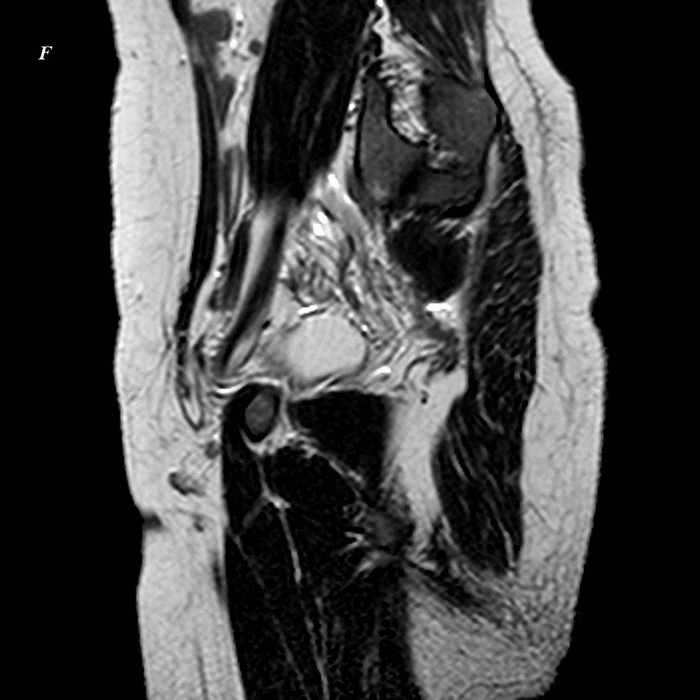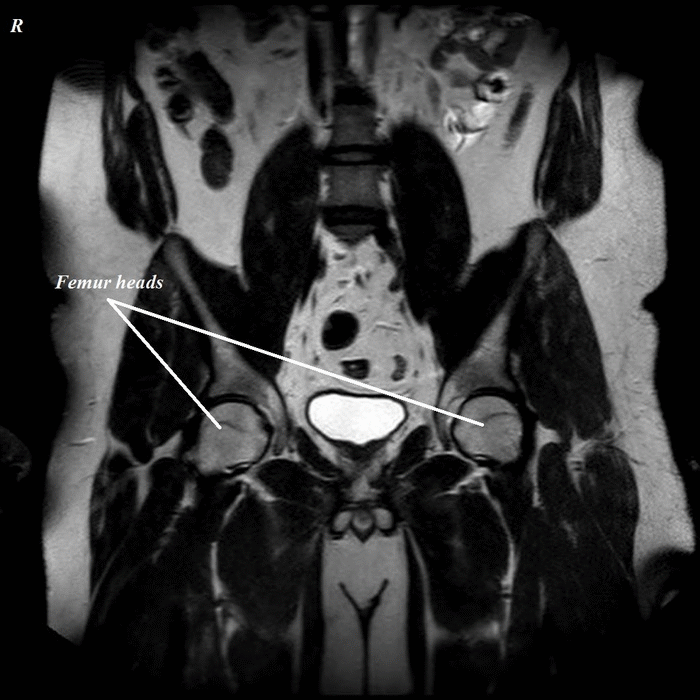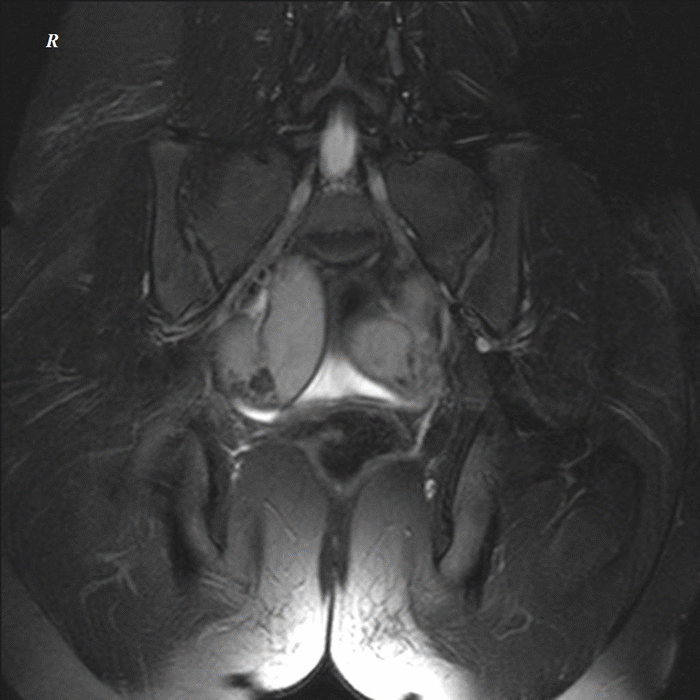Amenorrhea MRI: Difference between revisions
No edit summary |
m (Bot: Removing from Primary care) |
||
| (11 intermediate revisions by 3 users not shown) | |||
| Line 2: | Line 2: | ||
{{Amenorrhea}} | {{Amenorrhea}} | ||
{{CMG}} | {{CMG}}; {{AE}}{{EG}} | ||
==Overview== | ==Overview== | ||
There are no [[MRI]] findings associated with amenorrhea. However, a [[MRI]] may be helpful in the [[diagnosis]] of the [[diseases]] that can cause amenorrhea, such as [[Polycystic ovary syndrome|polycystic ovary syndrome (PCOS)]], [[androgen insensitivity syndrome]], anatomic [[genital]] defects, and also [[pituitary adenoma]]. | |||
==MRI== | ==MRI== | ||
* [[ | * There are no [[MRI]] findings associated with amenorrhea. However, a [[MRI]] may be helpful in the [[diagnosis]] of the [[diseases]] that can cause amenorrhea, such as [[Polycystic ovary syndrome|polycystic ovary syndrome (PCOS)]], [[androgen insensitivity syndrome]], anatomic [[genital]] defects, and also [[pituitary adenoma]]. | ||
{| align="right" | |||
| [[image:Webp.net-gifmaker (80).gif|thumb|500px|Polycystic ovary syndrome (PCOS) - Case courtesy of Dr Ahmed Mahrous Saied, Via Radiopaedia.org<ref>Radiopaedia.org. From the case <"https://radiopaedia.org/cases/32857">rID: 32857</ref>]] | |||
|- | | |||
| [[image:Webp.net-gifmaker (90).gif|thumb|500px|Intra-abdominal testes in androgen insensitivity syndrome - Case courtesy of Dr Dalia Ibrahim, Via Radiopaedia.org<ref>Radiopaedia.org. From the case <"https://radiopaedia.org/cases/29208">rID: 29208</ref>]] | |||
|- | | |||
| [[image:Webp.net-gifmaker (70).gif|thumb|500px|Transverse vaginal septum - Case courtesy of Dr Praveen Jha, Via Radiopaedia.org<ref>Radiopaedia.org. From the case <"https://radiopaedia.org/cases/16198">rID: 16198</ref>]] | |||
|} | |||
=== Polycystic ovary syndrome (PCOS) === | |||
*Rotterdam criteria is diagnostic of [[Polycystic ovary syndrome|polycystic ovary syndrome (PCOS)]]. Rotterdam criteria uses ultrasound findings which include:<ref name="pmid14714587">{{cite journal |vauthors=Balen AH, Laven JS, Tan SL, Dewailly D |title=Ultrasound assessment of the polycystic ovary: international consensus definitions |journal=Hum. Reprod. Update |volume=9 |issue=6 |pages=505–14 |year=2003 |pmid=14714587 |doi= |url=}}</ref> | |||
**Detecting 25 or more [[Follicle|follicles]]<ref name="pmid23503943">{{cite journal |vauthors=Lujan ME, Jarrett BY, Brooks ED, Reines JK, Peppin AK, Muhn N, Haider E, Pierson RA, Chizen DR |title=Updated ultrasound criteria for polycystic ovary syndrome: reliable thresholds for elevated follicle population and ovarian volume |journal=Hum. Reprod. |volume=28 |issue=5 |pages=1361–8 |year=2013 |pmid=23503943 |doi=10.1093/humrep/det062 |url=}}</ref> | |||
**Detecting increased [[ovarian]] volume > 10 cm<sup>3</sup> | |||
**Peripheral arrangement of cysts | |||
<br> | |||
<br> | |||
<br> | |||
<br> | |||
<br> | |||
<br> | |||
<br> | |||
<br> | |||
<br> | |||
<br> | |||
<br> | |||
<br> | |||
<br> | |||
<br> | |||
<br> | |||
<br> | |||
<br> | |||
<br> | |||
===Androgen insensitivity syndrome=== | |||
*Findings on an [[MRI]] suggestive of [[androgen insensitivity syndrome]] include:<ref name="TankKnoll2015">{{cite journal|last1=Tank|first1=Jay|last2=Knoll|first2=Abraham|last3=Gilet|first3=Anthony|last4=Kim|first4=Susanne|title=Imaging characteristics of androgen insensitivity syndrome|journal=Clinical Imaging|volume=39|issue=4|year=2015|pages=707–710|issn=08997071|doi=10.1016/j.clinimag.2015.02.002}}</ref> | |||
**Bilateral [[cryptorchidism]] | |||
**Juxta-[[testicular]] [[Mullerian duct]] cysts | |||
**Absent or rudimentary [[uterus]] | |||
<br> | |||
<br> | |||
<br> | |||
<br> | |||
<br> | |||
<br> | |||
<br> | |||
<br> | |||
<br> | |||
<br> | |||
<br> | |||
<br> | |||
<br> | |||
<br> | |||
<br> | |||
<br> | |||
<br> | |||
<br> | |||
==='''Anatomic genital defects'''=== | |||
*Findings on an [[MRI]] suggestive of [[imperforate hymen]] include:<ref name="pmid21686660">{{cite journal| author=Lardenoije C, Aardenburg R, Mertens H| title=Imperforate hymen: a cause of abdominal pain in female adolescents. | journal=BMJ Case Rep | year= 2009 | volume= 2009 | issue= | pages= | pmid=21686660 | doi=10.1136/bcr.08.2008.0722 | pmc=3029536 | url=https://www.ncbi.nlm.nih.gov/entrez/eutils/elink.fcgi?dbfrom=pubmed&tool=sumsearch.org/cite&retmode=ref&cmd=prlinks&id=21686660 }}</ref> | |||
**Hypoechoic mass in the [[vagina]] ([[hematocolpos]]) and enlarged [[uterus]] ([[haematometra]]) | |||
**Normal [[ovaries]] | |||
*Findings on an [[MRI]] suggestive of transverse [[vaginal septum]] include: | |||
**[[Bicornuate uterus]] | |||
**[[Hematocolpos]] | |||
**[[Hematometra]] | |||
**[[Hematosalpinx]] | |||
<br> | |||
<br> | |||
<br> | |||
<br> | |||
<br> | |||
<br> | |||
<br> | |||
<br> | |||
<br> | |||
<br> | |||
<br> | |||
<br> | |||
<br> | |||
<br> | |||
<br> | |||
<br> | |||
<br> | |||
<br> | |||
=== Pituitary adenoma === | |||
* [[Brain]] [[MRI]] may be helpful in the diagnosis of the cause of amenorrhea. Findings on [[MRI]] suggestive of amenorrhea include:<ref name="pmid26194704">{{cite journal |vauthors=Boehm U, Bouloux PM, Dattani MT, de Roux N, Dodé C, Dunkel L, Dwyer AA, Giacobini P, Hardelin JP, Juul A, Maghnie M, Pitteloud N, Prevot V, Raivio T, Tena-Sempere M, Quinton R, Young J |title=Expert consensus document: European Consensus Statement on congenital hypogonadotropic hypogonadism--pathogenesis, diagnosis and treatment |journal=Nat Rev Endocrinol |volume=11 |issue=9 |pages=547–64 |year=2015 |pmid=26194704 |doi=10.1038/nrendo.2015.112 |url=}}</ref> | |||
** [[Hypothalamus|Hypothalamo]]-[[pituitary]] lesions | ** [[Hypothalamus|Hypothalamo]]-[[pituitary]] lesions | ||
** [[Optic nerve]] compression ([[pituitary adenoma]]) | ** [[Optic nerve]] compression ([[pituitary adenoma]]) | ||
** [[Inner ear]] abnormalities ([[CHARGE syndrome]]) | ** [[Inner ear]] abnormalities ([[CHARGE syndrome]]) | ||
* [[Brain]] [[MRI]] is indicated in patients with | * [[Brain]] [[MRI]] is indicated in patients with amenorrhea, experiencing some alarm signs, such as [[headache]], [[visual impairment]], and behavioral changes. | ||
<gallery align="left"> | <gallery align="left"> | ||
image:Pituitary-adenoma-1.jpg|thumb|300px|Pituitary adenoma - Case courtesy of A.Prof Frank Gaillard<ref name="https://radiopaedia.org/">Radiopaedia.org. From the case <"https://radiopaedia.org/cases/16890">rID: 16890</ref> | image:Pituitary-adenoma-1.jpg|thumb|300px|Pituitary adenoma - Case courtesy of A.Prof Frank Gaillard, Via Radiopaedia.org<ref name="https://radiopaedia.org/">Radiopaedia.org. From the case <"https://radiopaedia.org/cases/16890">rID: 16890</ref> | ||
image:Hypothalamic-hamartoma.jpeg|thumb|300px|Hypothalamic lesion - Case courtesy of A.Prof Frank Gaillard<ref name="https://radiopaedia.org/">Radiopaedia.org. From the case <"https://radiopaedia.org/cases/16890">rID: 16890</ref> | image:Hypothalamic-hamartoma.jpeg|thumb|300px|Hypothalamic lesion - Case courtesy of A.Prof Frank Gaillard, Via Radiopaedia.org<ref name="https://radiopaedia.org/">Radiopaedia.org. From the case <"https://radiopaedia.org/cases/16890">rID: 16890</ref> | ||
image:Pituitary-macroadenoma-non-functioning-null-cell (1).jpg|thumb|300px|Pituitary non-functioning macroadenoma - Case courtesy of A.Prof Frank Gaillard<ref name="https://radiopaedia.org/">Radiopaedia.org. From the case <"https://radiopaedia.org/cases/5562">rID: 5562</ref> | image:Pituitary-macroadenoma-non-functioning-null-cell (1).jpg|thumb|300px|Pituitary non-functioning macroadenoma - Case courtesy of A.Prof Frank Gaillard, Via Radiopaedia.org<ref name="https://radiopaedia.org/">Radiopaedia.org. From the case <"https://radiopaedia.org/cases/5562">rID: 5562</ref> | ||
</gallery> | </gallery> | ||
==References== | ==References== | ||
{{reflist|2}} | {{reflist|2}} | ||
{{WH}} | |||
{{WS}} | |||
[[Category: | [[Category:Medicine]] | ||
[[Category:Endocrinology]] | [[Category:Endocrinology]] | ||
[[Category:Up-To-Date]] | |||
[[Category:Gynecology]] | [[Category:Gynecology]] | ||
[[Category:Obstetrics]] | |||
[[Category:Radiology]] | |||
Latest revision as of 20:22, 29 July 2020
|
Amenorrhea Microchapters |
|
Patient Information |
|---|
|
Diagnosis |
|
Treatment |
|
Case Studies |
|
Amenorrhea MRI On the Web |
|
American Roentgen Ray Society Images of Amenorrhea MRI |
Editor-In-Chief: C. Michael Gibson, M.S., M.D. [1]; Associate Editor(s)-in-Chief: Eiman Ghaffarpasand, M.D. [2]
Overview
There are no MRI findings associated with amenorrhea. However, a MRI may be helpful in the diagnosis of the diseases that can cause amenorrhea, such as polycystic ovary syndrome (PCOS), androgen insensitivity syndrome, anatomic genital defects, and also pituitary adenoma.
MRI
- There are no MRI findings associated with amenorrhea. However, a MRI may be helpful in the diagnosis of the diseases that can cause amenorrhea, such as polycystic ovary syndrome (PCOS), androgen insensitivity syndrome, anatomic genital defects, and also pituitary adenoma.
 |
 |
 |
Polycystic ovary syndrome (PCOS)
- Rotterdam criteria is diagnostic of polycystic ovary syndrome (PCOS). Rotterdam criteria uses ultrasound findings which include:[4]
Androgen insensitivity syndrome
- Findings on an MRI suggestive of androgen insensitivity syndrome include:[6]
- Bilateral cryptorchidism
- Juxta-testicular Mullerian duct cysts
- Absent or rudimentary uterus
Anatomic genital defects
- Findings on an MRI suggestive of imperforate hymen include:[7]
- Hypoechoic mass in the vagina (hematocolpos) and enlarged uterus (haematometra)
- Normal ovaries
- Findings on an MRI suggestive of transverse vaginal septum include:
Pituitary adenoma
- Brain MRI may be helpful in the diagnosis of the cause of amenorrhea. Findings on MRI suggestive of amenorrhea include:[8]
- Hypothalamo-pituitary lesions
- Optic nerve compression (pituitary adenoma)
- Inner ear abnormalities (CHARGE syndrome)
- Brain MRI is indicated in patients with amenorrhea, experiencing some alarm signs, such as headache, visual impairment, and behavioral changes.
-
Pituitary adenoma - Case courtesy of A.Prof Frank Gaillard, Via Radiopaedia.org[9]
-
Hypothalamic lesion - Case courtesy of A.Prof Frank Gaillard, Via Radiopaedia.org[9]
-
Pituitary non-functioning macroadenoma - Case courtesy of A.Prof Frank Gaillard, Via Radiopaedia.org[9]
References
- ↑ Radiopaedia.org. From the case <"https://radiopaedia.org/cases/32857">rID: 32857
- ↑ Radiopaedia.org. From the case <"https://radiopaedia.org/cases/29208">rID: 29208
- ↑ Radiopaedia.org. From the case <"https://radiopaedia.org/cases/16198">rID: 16198
- ↑ Balen AH, Laven JS, Tan SL, Dewailly D (2003). "Ultrasound assessment of the polycystic ovary: international consensus definitions". Hum. Reprod. Update. 9 (6): 505–14. PMID 14714587.
- ↑ Lujan ME, Jarrett BY, Brooks ED, Reines JK, Peppin AK, Muhn N, Haider E, Pierson RA, Chizen DR (2013). "Updated ultrasound criteria for polycystic ovary syndrome: reliable thresholds for elevated follicle population and ovarian volume". Hum. Reprod. 28 (5): 1361–8. doi:10.1093/humrep/det062. PMID 23503943.
- ↑ Tank, Jay; Knoll, Abraham; Gilet, Anthony; Kim, Susanne (2015). "Imaging characteristics of androgen insensitivity syndrome". Clinical Imaging. 39 (4): 707–710. doi:10.1016/j.clinimag.2015.02.002. ISSN 0899-7071.
- ↑ Lardenoije C, Aardenburg R, Mertens H (2009). "Imperforate hymen: a cause of abdominal pain in female adolescents". BMJ Case Rep. 2009. doi:10.1136/bcr.08.2008.0722. PMC 3029536. PMID 21686660.
- ↑ Boehm U, Bouloux PM, Dattani MT, de Roux N, Dodé C, Dunkel L, Dwyer AA, Giacobini P, Hardelin JP, Juul A, Maghnie M, Pitteloud N, Prevot V, Raivio T, Tena-Sempere M, Quinton R, Young J (2015). "Expert consensus document: European Consensus Statement on congenital hypogonadotropic hypogonadism--pathogenesis, diagnosis and treatment". Nat Rev Endocrinol. 11 (9): 547–64. doi:10.1038/nrendo.2015.112. PMID 26194704.
- ↑ 9.0 9.1 9.2 Radiopaedia.org. From the case <"https://radiopaedia.org/cases/16890">rID: 16890
![Pituitary adenoma - Case courtesy of A.Prof Frank Gaillard, Via Radiopaedia.org[9]](/images/1/12/Pituitary-adenoma-1.jpg)
![Hypothalamic lesion - Case courtesy of A.Prof Frank Gaillard, Via Radiopaedia.org[9]](/images/6/66/Hypothalamic-hamartoma.jpeg)
![Pituitary non-functioning macroadenoma - Case courtesy of A.Prof Frank Gaillard, Via Radiopaedia.org[9]](/images/a/a2/Pituitary-macroadenoma-non-functioning-null-cell_%281%29.jpg)